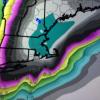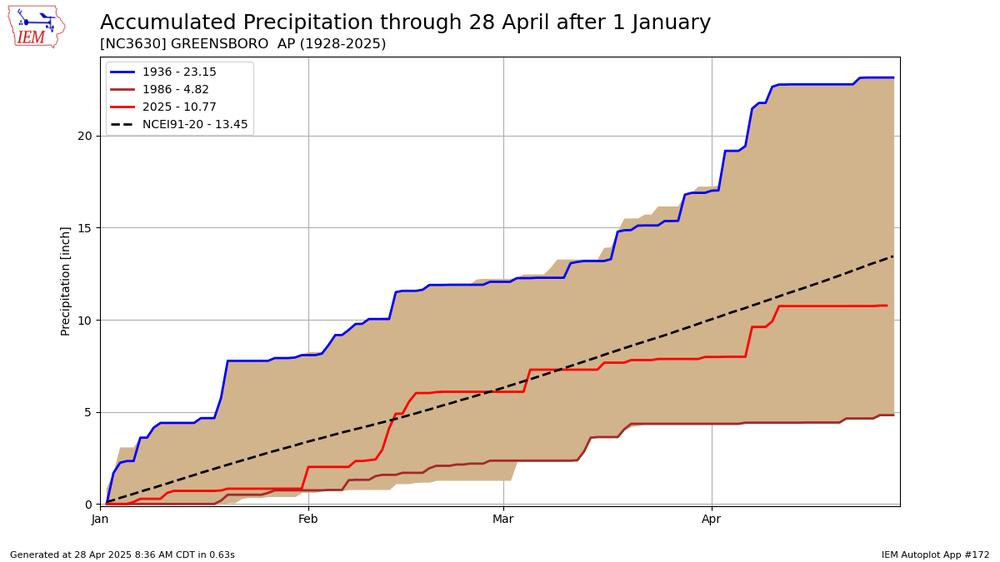All Activity
- Past hour
-
Something human I see about your posts is that they involve a large degree of projection. I can tell you are bothered about the lack of cold and snowy winters and it’s leading to you being very critical of anyone that is pointing out the obvious. Viewing scientific principles through political filter usually doesn’t lead to success. But sometimes people are willing to sacrifice forecast accuracy in service to holding onto outdated beliefs. What you classify as superiority is actually maintaining focus on the big picture. I have worked very hard to eliminate biases over the years. It’s actually been easier to do with weather statistics and patterns which hold no emotion for me. Maybe this is what you are perceiving as superiority. I try not to get emotional about the weather and climate.
-
Gorgeous week ahead minus shoes showers and a few tstorms Tuesday evening.
-
They also know how to fail in big moments which is what Wednesday night is! End the series Wednesday night and get a few days or rest and healing!
-
Assuming we get nothing tomorrow night, May '24-April '25 is 92% of average. BN but not Stein-worthy.
-
64° already
-
Tomorrow looks like a more classic CEF maybe to BDL and then ENE to MHT-LWM day. For best warmth anyways. Might be just a bit too much SSW flow south of there to push bigger warmth. Sill warm regardless.
-

2025-2026 ENSO
40/70 Benchmark replied to 40/70 Benchmark's topic in Weather Forecasting and Discussion
I absolutely have a bias towards cold and snow that I have been working to mitigate and the only way to begin successfully doing so is to own it. If your only agenda is truly to get the pattern correct, then I would suggest taking the self-preserving-blinders off and develop even a modicum of personal insight. -
-
Is it me or is SPC just on it this year? The day 4-7 outlooks have been so spot on. Good luck to all chasing or those in the prime area. Stay safe!
-
The Euro updated seasonal forecast for the summer will be out on May 5th. It actually has been one of the better periods for seasonal forecast skill of summer temperatures and 500 mb patterns. My guess is that this dry pattern will generally continue into the summer as it has been very persistent especially in Eastern PA into NJ. The last time we had a dry pattern heading into the summer was 2022. This is when NJ reached 100° over 5 times but the areas further east had more onshore flow and less 100° heat than NJ. So our first hints on summer wind direction will probably come with the Euro update on May 5th.
-

2025-2026 ENSO
40/70 Benchmark replied to 40/70 Benchmark's topic in Weather Forecasting and Discussion
And I chuckle when folks have yet to realize that CC has been as heavily politicized as any other topic. Again...I urge you to begin a poll in which folks can chime in anonymously regarding whether or not you follow the data, or engineer the data to follow your preconceived notion. If the majority doesn't believe that you have a bias, then I'll venmo you $300. You have this air of superiority as if you aren't prone to the same biases that we mere mortals are....I'm going to let you in on a little secret....come closer....(whispers) you're human, too. Thus its important to wait on these sweeping proclomations that dispell theories supported by at least several decades of data. Perhaps you are 100% correct on everything, I wouldn't necessarily doubt it, you seem bright; but we do not know that yet. -
My only agenda has been getting the pattern correct. I have to chuckle when I see posts such as yours which often use the term agenda. Since agenda is generally a political term that has nothing to do with weather and climate forecasting.
-
65 as of 9:15 .. up from 41, but the 41 was captured at 3:30 or so after a couple hours of decoupling. Obs nearby FIT and locally suggests we coupled back up and temperatures began rising roughly around that time going forward. The rate of rise and the surrounding other observations et al suggest in total we'll be above 70 anyway. MET's been 77-ish along the BDL-FIT-ASH arc, which would put today in contention if not succeeding in the greatest diurnal range day of the year. I always like to track that admittedly tedious nerdiness
-
2.52 for my area
-
They are up 3-1 right now though?
-

2025-2026 ENSO
40/70 Benchmark replied to 40/70 Benchmark's topic in Weather Forecasting and Discussion
Its much easier to perpetuate your theory when you keep adjusting concepts predicated on your theory BEFORE an adequate pool of data is in. -
I was 36 this morning, but undergoing a rapid rise. Currently 60 now at 9am.
-

2025-2026 ENSO
40/70 Benchmark replied to 40/70 Benchmark's topic in Weather Forecasting and Discussion
Much like I believe snowfall will incease again, I also am of the firm belief that the PDO will spend a great deal more time in the positive phase next decade....and if it doesn't, THEN and only then, is it time to consider a change like that. Not now- -
That site loves to radiate.
-
That 1928 coastal must have been something. https://www.wtaj.com/weather/the-late-april-snowstorm-of-1928/
-

2025-2026 ENSO
40/70 Benchmark replied to 40/70 Benchmark's topic in Weather Forecasting and Discussion
You keep passing off these sweeping judgements, such as the "the long 30 year cycles have become a thing of the past" as if they are fact...they aren't. Its your opnion. Then if an index doesn't fit your agenda, you dismiss it and insert some alternate index. It doesn't work that way....I may consider the ONI archaic, but I still factor it in. I just include other metrics to more accurately depict the intensity of modern ENSO events. - Today
-

2025-2026 ENSO
40/70 Benchmark replied to 40/70 Benchmark's topic in Weather Forecasting and Discussion
I mean in the cold multidecadal phase, not locked into the cold phase, per se. I figured that was tacit. The variation happens in every multidecadal phase....there is alway some oscillation within the larger multidecadal phase. Its never literally in one state for 30 years, however, one phase is perdominant dependent on the longer term, multidecadal trend. -
Already near 60
-
April rainfall (28th) site / actual (monthly avg) EWR: 2.39 (3.99) NYC: 3.25 (4.21) LGA: 2.84 (3.99) JFK: 2.17 ( 3.62) PHL: 2.83 (3.65)
-
Records: Highs: EWR: 90 (2009) NYC: 90 (2009) LGA: 89 (2009) JFK: 85 (2009) Lows: EWR: 33 (1934) NYC: 31 (1874) LGA: 36 (1947) JFK: 37 (1966) Historical: 1893: A half-mile wide estimated F4 tornado killed 23 people and injured 150 as it tore a path of devastation through Cisco, Texas. Every building in the town was either destroyed or severely damaged. 1921 - A severe hailstorm in Anson County, NC, produced hail the size of baseballs. Gardens, grain fields and trees were destroyed. Pine trees in the storm's path had to be cut for lumber because of the hail damage. (The Weather Channel) 1928 - A coastal storm produced tremendous late season snows in the Central Appalachians, including 35 inches at Bayard WV, 31 inches at Somerset PA, and 30 inches at Grantsville MD. High winds accompanying the heavy wet snow uprooted trees and unroofed a number of homes. The storm caused great damage to fruit trees and wild life. (David Ludlum) (The Weather Channel) 1973: The record crest of the Mississippi River at St. Louis, Missouri was registered at 43.23 feet on this day. This level exceeded the previous 1785 mark by 1.23 feet. This record was broken during the 1993 Flood when the Mississippi River crested at 49.58 feet on August 1st. At Memphis, Tennessee, the Mississippi was over flood stage for 63 days, more than that of the historic 1927 flood, and the river was above flood stage for an even longer 107 days at upstream Cairo, Illinois. Out of the seven largest floods on the Mississippi between 1927 and 1997, the 1973 event ranked third in both volume discharged and duration but only sixth in flood height. Over $250 million of damages were incurred mainly in the Mississippi Valley states of Missouri, Arkansas, Tennessee, Mississippi, and Louisiana. 1987 - Twenty cities in the western and central U.S. reported record high temperatures for the date. Highs of 95 degrees at Houston TX, 95 degrees at Lake Charles LA, and 94 degrees at Port Arthur TX, were April records. (The National Weather Summary) 1988 - Miami, FL, hit 92 degrees, marking a record eight days of 90 degree heat in the month of April. Squalls produced snow in the Washington D.C. area. Belvoir VA reported a temperature reading of 57 degrees at the time the snow began. (Storm Data) (The National Weather Summary) 1989 - Strong northerly winds and heavy snow ushered cold air into the north central U.S. Snowfall totals in Montana ranged up to 20 inches at Miles City. Thunderstorms produced severe weather from eastern Texas to the Southern Appalachians and the southern Ohio Valley. Hail four and a half inches in diameter was reported at Keller TX and White Settlement TX. (Storm Data) (The National Weather Summary) 1990 - Thunderstorms produced severe weather in the southeastern U.S. during the day. Severe thunderstorms spawned four tornadoes, including one which injured four persons at Inman SC. There were also more than one hundred reports of large hail and damaging winds, with better than half of those reports in Georgia. Strong thunderstorm winds injured four people at Sadler's Creek SC. (The National Weather Summary) (Storm Data) Twenty-nine cities in the northeastern U.S. reported record high temperatures for the date as readings soared into the 80s and lower 90s. Highs of 88 degrees at Binghamton NY, 94 degrees at Buffalo NY, 89 degrees at Erie PA, 90 degrees at Newark NJ, 93 degrees at Rochester NY and 92 degrees at Syracuse NY, were records for the month of April. (The National Weather Summary) 1991: Memphis, Tennessee recorded their wettest April ever with 15.03 inches, breaking their previous record of 13.90 inches in 1872. 2002: During the evening hours, a violent F4 tornado carved a 64-mile path across southeast Maryland. The La Plata, Maryland tornado was part of a larger severe weather outbreak that began in the mid-Mississippi Valley early on that day and spread across portions of the Ohio Valley and the Mid-Atlantic States. In Maryland, three deaths and 122 injuries were a direct result of the storm. Property damage exceeded $100 million. Tornadoes along the Atlantic coast are not frequent, and tornadoes of this magnitude are extremely rare. Only six F4 tornadoes have occurred farther north and east of the La Plata storm: Worchester, Massachusetts - 1953; New York/Massachusetts - 1973; Windsor Locks, Connecticut - 1979; five counties in New York - 1989; New Haven, Connecticut - 1989; North Egremont, Massachusetts - 1995. None was as close to the coast. The tornado traveled across the Chesapeake Bay almost to the Atlantic.













